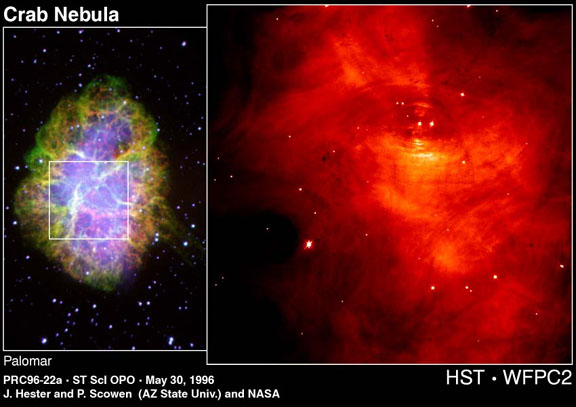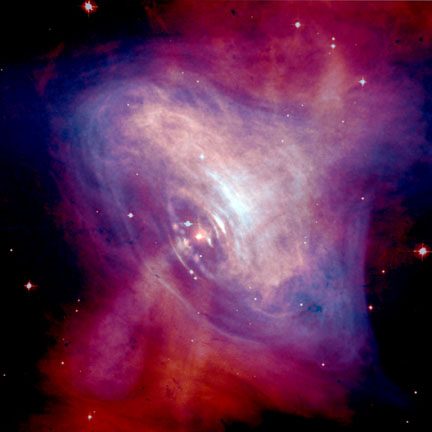On July 4th, 1054, Chinese spotted a new star in the sky. It was a supernova. This supernova was visible April 6, 1056. (From the May 2003 article in Sky & Telescope by F. Richard Stephenson and David A. Green.) When later astronmers discovered the nebula left behind by this supernova, they thought it resembled a crab. Thus, it was called the Crab Nebula. In 1963, the it was discovered that radio waves were coming from the Crab Nebula. In 1968, it was discovered that there was a pulsar at the heart of the Crab Nebula. It has become known as the Crab Pulsar.
An image of the Crab Nebula and Crab Pulsar from the Hubble Space Telescope is shown below.

Below is a composite image that came from both the Chandra X-Ray Telescope and the Hubble Space Telescope.

A large time lapse movie of the Crab Nebula and its Pulsar exists at this location at the Hubble web site.
The traditional theory of how pulsars states that they are spinning neutron stars. The movie above obviously shows a real pulsar that is not spinning.
My theory for how a pulsar works states that the pulse is created by a strong electromagnetic wave sweeping back and forth, from pole to pole, over a single, very large elementary particle -- a large decaying ball-of-light. When I look at the Crab Nebula Movie it very clearly shows this process.
The Ball-of-Light Particle Model explains how the electromagnetic fields on a decaying ball-of-light -- like the object at the center of a pulsar -- ejects smaller balls-of-light off the poles. (The process is very similar to how sunspots are induced.) (See also Planetary Nebulae.) Below is an animated gif showing the process.
Images and animations of the Crab Pulsar show objects be ejected from the poles of the pulsar as the all-of-Light Particle Model predicts. I believe they are induced balls-of-light -- elementary particles that are many miles across.
The Ball-of-Light Particle Model predicts that the Magnetic field of a pulsar will be polarized in opposite directions on opposite hemispheres of the pulsar. This will affect the nebula around the pulsar, creating pulsing, waves radiating outward through the ionized nebula in the plane of the pulsar's equator. This can be graphically seen in the Crab Nebula Movie. I will add graphics and animations to better describe this in the future.
All detailed evidence of the Crab Nebula contradicts traditional theory of star formation. All detailed evidence of the Crab Nebula confirms the Ball-of-Light Particle Model.